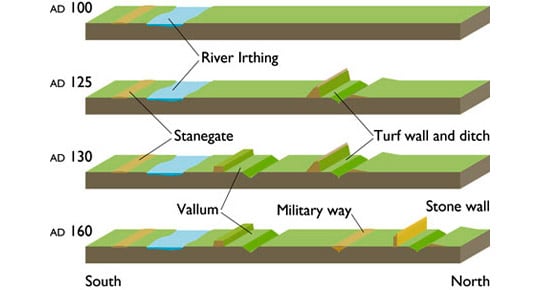Significance of Birdoswald Roman Fort
Birdoswald is an extremely well-preserved fort, with a totally excavated defensive circuit. As the only fort extensively excavated on the turf sector of Hadrian’s Wall, it has produced more archaeological evidence for the phases of construction of the Wall than any other. It was also the first fort to produce substantial evidence for what happened on the Wall when Roman rule in Britain ended.

State of Preservation
Excavation has shown that the buried archaeology is very finely preserved. Of the visible remains the most important are:
- the well-preserved defensive circuit, including five of the original six gates
- two well-preserved buttressed granaries
- traces of early post-Roman timber buildings overlying the granaries
- earthworks of medieval cultivation
- foundations of a medieval tower house and a 16th-century bastle house
- the multi-period farmhouse presenting a Victorian Gothic exterior.
ARCHAEOLOGICAL INVESTIGATIONS
The size and layout of the fort were established by excavations on the outer walls and gates in the 1850s. During the 1890s Francis Haverfield attempted to establish the relationship between the stone Wall, turf Wall, fort and Vallum (the earthwork to the south of the Wall).[1] In the 1920s and 1930s FG Simpson and Ian Richmond concentrated on Birdoswald in order to work out the building sequence of the frontier in more detail.[2]
Excavations in 1929 on a barrack block on the eastern side of the fort recovered datable finds and two major inscriptions, leading to the formulation of the system of four chronological periods for Hadrian’s Wall. This system remained the basis for Wall studies for the next half-century. In 1961 Professor Eric Birley stated that Birdoswald was ‘in the record of Wall research … even more important than Greatchesters or Housesteads or Chesters’.[3]
Since then, excavations by English Heritage from 1987 to 2000 and in 2010 have:
- confirmed the history of the early phases of the fort and Hadrian’s Wall
- revealed the immediate post-Roman history of a fort on the Wall for the first time
- explored the vicus (civilian settlement) outside the fort walls and examined the fort cemetery[4]
- identified a large exercise hall – again a first in Roman fort research.
Geophysical survey at Birdoswald has established, again for the first time, the extent of the vicus.[5]
The archaeological significance of Birdoswald has placed the site firmly in the forefront of research on Hadrian’s Wall.
READ MORE ABOUT BIRDOSWALD ROMAN FORT
Footnotes
1. See Haverfield’s reports in Transactions of the Cumberland and Westmorland Antiquarian and Archaeological Society, old series, 15 (1898), 172–90 and 197–200; old series, 15 (1899), 345–64 (accessed 30 August 2013).
2. See Simpson and Richmond’s reports in Transactions of the Cumberland and Westmorland Antiquarian and Archaeological Society, new series, 32 (1932), 140–45; 33 (1933), 246–62; 34 (1934), 120–30.
3. E Birley, Research on Hadrian’s Wall (Kendal, 1961).
4. T Wilmott, Birdoswald: Excavations of a Roman Fort on Hadrian’s Wall and its Successor Settlements: 1987–92, English Heritage Archaeological Report 14 (Swindon, 1997); T Wilmott (ed), Hadrian’s Wall: Archaeological Research by English Heritage 1976–2000 (Swindon, 2009).
5. JA Biggins and DJA Taylor, ‘A survey of the Roman fort and settlement at Birdoswald, Cumbria’, Britannia, 30 (1999), 91–110 (subscription required; accessed 31 July 2013); JA Biggins and DJA Taylor, ‘Geophysical survey of the vicus at Birdoswald Roman Fort, Cumbria’, Britannia, 35 (2004), 159–77 (subscription required; accessed 31 July 2013).